Understanding the Temperature Variations and Thermal Structure of a Subtropical Deep River-Run Reservoir before and after Impoundment
Abstract
:1. Introduction
2. Materials and Methods
2.1. Study Site
2.2. Observed Water Temperatures
2.3. Two-Dimensional Simulation Model
2.3.1. Hydrometric Input Data
2.3.2. Meteorological Input Data
2.4. Annual Temperature Variations
2.5. Hydraulic Residence Time and Water Age
2.6. Definition of Stable Stratification
2.7. Equivalent Heat Flux of Inflow and Outflow
3. Results and Discussions
3.1. Annual Temperature Variations before and after Impoundment
3.1.1. Temperature before Impoundment
3.1.2. Temperature after Impoundment
3.1.3. Relationship between Air and Water Temperature
3.2. Xiluodu Reservoir (XLDR) Model Calibration
3.3. Thermal Structure in Xiluodu Reservoir (XLDR)
3.3.1. Thresholds of Vertical Temperature Gradient and N for Stratification
3.3.2. Stratification in the First Year of Impoundment
3.3.3. The Weak Stratification Period
3.3.4. The Stratification in the Second Year of Impoundment
3.4. The Factors Involving the Formation and Variation of Stratification
3.4.1. Scenarios Settings
3.4.2. The Influence of Flow Rate
3.4.3. The Influence of Withdrawn Elevation
3.5. The Factors Involving Phase Differences between Inflow and Outflow Temperature
4. Summary and Conclusions
Acknowledgments
Author Contributions
Conflicts of Interest
References
- Owens, E.M.; Effler, S.W.; Trama, F. Variability in thermal stratification in a reservoir. JAWRA J. Am. Water Resour. Assoc. 1986, 22, 219–227. [Google Scholar] [CrossRef]
- Shimoda, Y.; Azim, M.E.; Perhar, G.; Ramin, M.; Kenney, M.A.; Sadraddini, S.; Gudimov, A.; Arhonditsis, G.B. Our current understanding of lake ecosystem response to climate change: What have we really learned from the north temperate deep lakes? J. Great Lakes Res. 2011, 37, 173–193. [Google Scholar] [CrossRef]
- Webb, B.W.; Walling, D.E. Complex summer water temperature behaviour below a UK regulating reservoir. Regul. Rivers: Res. Manag. 1997, 13, 463–477. [Google Scholar] [CrossRef]
- Steel, E.A.; Lange, I.A. Using wavelet analysis to detect changes in water temperature regimes at multiple scales: Effects of multi-purpose dams in the Willamette River basin. River Res. Appl. 2007, 23, 351–359. [Google Scholar] [CrossRef]
- Olden, J.D.; Naiman, R.J. Incorporating thermal regimes into environmental flows assessments: Modifying dam operations to restore freshwater ecosystem integrity. Freshw. Biol. 2010, 55, 86–107. [Google Scholar] [CrossRef]
- Webb, B.W.; Hannah, D.M.; Moore, R.D.; Brown, L.E.; Nobilis, F. Recent advances in stream and river temperature research. Hydrol. Process. 2008, 22, 902–918. [Google Scholar] [CrossRef]
- Caissie, D. The thermal regime of rivers: A review. Freshw. Biol. 2006, 51, 1389–1406. [Google Scholar] [CrossRef]
- Webb, B.W.; Nobilis, F. Long term water temperature trends in Austrian rivers. Hydrol. Sci. J. 1995, 40, 83–96. [Google Scholar] [CrossRef]
- Webb, B.W.; Walling, D.E. Long-term variability in the thermal impact of river impoundment and regulation. Appl. Geogr. 1996, 16, 211–223. [Google Scholar] [CrossRef]
- Hamblin, P.F.; McAdam, S.O. Impoundment effects on the thermal regimes of Kootenay Lake, the Arrow Lakes Reservoir and Upper Columbia River. Hydrobiologia 2003, 504, 3–19. [Google Scholar] [CrossRef]
- Rheinheimer, D.E.; Null, S.E.; Lund, J.R. Optimizing selective withdrawal from reservoirs to manage downstream temperatures with climate warming. J. Water Resour. Plan. Manag. 2015, 141. [Google Scholar] [CrossRef]
- Chen, G.; Fang, X.; Devkota, J. Understanding flow dynamics and density currents in a river-reservoir system under upstream reservoir releases. Hydrol. Sci. J. 2015. [Google Scholar] [CrossRef]
- Lowney, C.L. Stream temperature variation in regulated rivers: Evidence for a spatial pattern in daily minimum and maximum magnitudes. Water Resour. Res. 2000, 36, 2947–2956. [Google Scholar] [CrossRef]
- Preece, R.M.; Jones, H.A. The effect of Keepit Dam on the temperature regime of the Namoi River, Australia. River Res. Appl. 2002, 18, 397–414. [Google Scholar] [CrossRef]
- Webb, B.W.; Nobilis, F. Long-term changes in river temperature and the influence of climatic and hydrological factors. Hydrol. Sci. J. 2007, 52, 74–85. [Google Scholar] [CrossRef]
- Ford, D.E.; Stefan, H. Stratification variability in three morphometrically different lakes under identical meteorological forcing. JAWRA J. Am. Water Resour. Assoc. 1980, 16, 243–247. [Google Scholar] [CrossRef]
- Imberger, J. The diurnal mixed layer. Limnol. Oceanogr. 1985, 30, 737–770. [Google Scholar] [CrossRef]
- Monismith, S.G.; Imberger, J.; Morison, M.L. Convective motions in the sidearm of a small reservoir. Limnol. Oceanogr. 1990, 35, 1676–1702. [Google Scholar] [CrossRef]
- Monismith, S.G. Wind-forced motions in stratified lakes and their effect on mixed-layer shear. Limnol. Oceanogr. 1985, 30, 771–783. [Google Scholar] [CrossRef]
- Alcântara, E.H.; Stech, J.L.; Lorenzzetti, J.A.; Bonnet, M.P.; Casamitjana, X.; Assireu, A.T. Remote sensing of water surface temperature and heat flux over a tropical hydroelectric reservoir. Remote Sens. Environ. 2010, 114, 2651–2665. [Google Scholar] [CrossRef]
- Riera, J.; Jaume, D.; De Manuel, J.; Morgui, J.; Armengol, J. Patterns of variation in the limnology of Spanish reservoirs: A regional study. Limnetica 1992, 8, 111–123. [Google Scholar]
- StrašKraba, M. Limnological basis for modeling reservoir ecosystems. In Man-Made Lakes: Their Problems and Environmental Effects; American Geophysical Union: Washington, DC, USA, 1973; pp. 517–535. [Google Scholar]
- Carmack, E.C. Combined influence of inflow and lake temperatures on spring circulation in a riverine lake. J. Phys. Oceanogr. 1979, 9, 422–434. [Google Scholar] [CrossRef]
- Nowlin, W.H.; Davies, J.-M.; Nordin, R.N.; Mazumder, A. Effects of water level fluctuation and short-term climate variation on thermal and stratification regimes of a British Columbia reservoir and lake. Lake Reserv. Manag. 2004, 20, 91–109. [Google Scholar] [CrossRef]
- Casamitjana, X.; Serra, T.; Colomer, J.; Baserba, C.; Perez-Losada, J. Effects of the water withdrawal in the stratification patterns of a reservoir. Hydrobiologia 2003, 504, 21–28. [Google Scholar] [CrossRef]
- Dan, B.M.; Arneson, R.D. Comparative limnology of a deep-discharge reservoir and a surface-discharge lake on the Madison River, Montana. Freshw. Biol. 1978, 8, 33–42. [Google Scholar]
- Çalışkan, A.; Elçi, Ş. Effects of selective withdrawal on hydrodynamics of a stratified reservoir. Water Resour. Manag. 2009, 23, 1257–1273. [Google Scholar] [CrossRef]
- Chen, G.; Fang, X. Sensitivity analysis of flow and temperature distributions of density currents in a river-reservoir system under upstream releases with different durations. Water 2015, 7, 6244–6268. [Google Scholar] [CrossRef]
- Li, Z.; Zhu, D.; Chen, Y.; Fang, X.; Liu, Z.; Ma, W. Simulating and understanding effects of water level fluctuations on thermal regimes in Miyun Reservoir. Hydrol. Sci. J./J. Des Sci. Hydrol. 2016, 61, 952–969. [Google Scholar] [CrossRef]
- Akiyama, J.; Stefan, H.G. Gravity Currents in Lakes, Reservoirs and Coastal Regions: Two-Layer Stratified Flow Analysis; St. Anthony Falls Hydraulic Laboratory: Minneapolis, MN, USA, 1987. [Google Scholar]
- Akiyama, J.; Stefan, H.G. Plunging flow into a reservoir: Theory. J. Hydraul. Eng. 1984, 110, 484–499. [Google Scholar] [CrossRef]
- Alavian, V.; Jirka, G.H.; Denton, R.A.; Johnson, M.C.; Stefan, H.G. Density currents entering lakes and reservoirs. J. Hydraul. Eng.-Asce 1992, 118, 1464–1489. [Google Scholar] [CrossRef]
- Alavian, V. Behavior of density currents on an Incline. J. Hydraul. Eng. 1986, 112, 27–42. [Google Scholar] [CrossRef]
- Ma, H.; He, H.; Jc, P.; Rs, S. Entrainment into two-dimensional and axisymmetric turbulent gravity currents. J. Fluid Mech. 1996, 308, 289–311. [Google Scholar]
- Carmack, E.C.; Gray, C.B.J.; Pharo, C.H.; Daley, R.J. Importance of lake-river interaction on seasonal patterns in the general circulation of Kamloops Lake, British Columbia. Limnol. Oceanogr. 1979, 24, 634–644. [Google Scholar] [CrossRef]
- Fischer, H.B.; Smith, R.D. Observations of transport to surface waters from a plunging inflow to Lake Mead. Limnol. Oceanogr. 1983, 28, 258–272. [Google Scholar] [CrossRef]
- Alavian, V.; Ostrowski, P. Use of density current to modify thermal structure of TVA reservoirs. J. Hydraul. Eng. 1992, 118, 688–706. [Google Scholar] [CrossRef]
- Dallimore, C.J.; Imberger, J.R.; Ishikawa, T. Entrainment and turbulence in saline underflow in Lake Ogawara. J. Hydraul. Eng. 2001, 127, 937–948. [Google Scholar] [CrossRef]
- Benyahya, L.; Sthilaire, A.; Quarda, T.B.M.J.; Bobée, B.; Ahmadinedushan, B. Modeling of water temperatures based on stochastic approaches: Case study of the Deschutes River. J. Environ. Eng. Sci. 2007, 6, 437–448. [Google Scholar] [CrossRef]
- Cole, T.M.; Wells, S.A. CE-QUAL-W2: A Two-Dimensional, Laterally Averaged, Hydrodynamic and Water Quality Model; Version 3.71; User Manual; Department of Civil and Environmental Engineering, Portland State University: Portland, OR, USA, 2013. [Google Scholar]
- Hanna, R.B.; Saito, L.; Bartholow, J.M.; Sandelin, J. Results of simulated temperature control device operations on in-reservoir and discharge water temperatures using CE-QUAL-W2. Lake Reserv. Manag. 1999, 15, 87–102. [Google Scholar] [CrossRef]
- Kurup, R.G.; Hamilton, D.P.; Phillips, R.L. Comparison of two 2-dimensional, laterally averaged hydrodynamic model applications to the Swan River Estuary. In Mathematics and Computers in Simulation; Elsevier Science Publishers B. V.: Amsterdam, The Netherlands, 2000; Volume 51, pp. 627–638. [Google Scholar]
- Debele, B.; Srinivasan, R.; Parlange, J.Y. Coupling upland watershed and downstream waterbody hydrodynamic and water quality models (SWAT and CE-QUAL-W2) for better water resources management in complex river basins. Environ. Model. Assess. 2008, 13, 135–153. [Google Scholar] [CrossRef]
- Kim, Y.; Kim, B. Application of a 2-dimensional water quality model (CE-QUAL-W2) to the turbidity interflow in a deep reservoir (Lake Soyang, Korea). Lake Reserv. Manag. 2009, 22, 213–222. [Google Scholar] [CrossRef]
- Mooij, W.M.; Trolle, D.; Jeppesen, E.; Arhonditsis, G.; Belolipetsky, P.V.; Chitamwebwa, D.B.R.; Degermendzhy, A.G.; DeAngelis, D.L.; De Senerpont Domis, L.N.; Downing, A.S.; et al. Challenges and opportunities for integrating lake ecosystem modelling approaches. Aquat. Ecol. 2010, 44, 633–667. [Google Scholar] [CrossRef] [Green Version]
- Deliman, P.N.; Gerald, J.A. Application of the two-dimensional hydrothermal and water quality model, CE-QUAL-W2, to the Chesapeake Bay–Conowingo Reservoir. Lake Reserv. Manag. 2002, 18, 10–19. [Google Scholar] [CrossRef]
- Bowen, J.D.; Hieronymus, J.W. A CE-QUAL-W2 model of Neuse Estuary for total maximum daily load development. J. Water Resour. Plan. Manag. 2003, 129, 283–294. [Google Scholar] [CrossRef]
- Rangel-Peraza, J.; Obregon, O.; Nelson, J.; Williams, G.; De Anda, J.; González-Farías, F.; Miller, J. Modelling approach for characterizing thermal stratification and assessing water quality for a large tropical reservoir. Lakes Reserv.: Res. Manag. 2012, 17, 119–129. [Google Scholar] [CrossRef]
- Dai, L.; Dai, H.; Jiang, D. Temporal and spatial variation of thermal structure in Three Gorges Reservoir: A simulation approach. J. Food Agric. Environ. 2012, 10, 1174–1178. [Google Scholar]
- Gang, C.; Xing, F. Accuracy of hourly water temperatures in rivers calculated from air temperatures. Water 2015, 7, 1068–1087. [Google Scholar]
- Tim Kraft, P.E. Green River CE-QUAL-W2 Project: A Hydrodynamic and Water Quality Study of the Green River King County, Washington; King County Department of Natural Resources and Parks: Seattle, WA, USA, 2004; pp. 1–280.
- Ostfeld, A.; Salomons, S. A hybrid genetic—Instance based learning algorithm for CE-QUAL-W2 calibration. J. Hydrol. 2005, 310, 122–142. [Google Scholar] [CrossRef]
- Zhang, H.; Culver, D.A.; Boegman, L. A two-dimensional ecological model of Lake Erie: Application to estimate dreissenid impacts on large lake plankton populations. Ecol. Model. 2008, 214, 219–241. [Google Scholar] [CrossRef]
- Blandford, T.R.; Humes, K.S.; Harshburger, B.J.; Moore, B.C.; Walden, V.P.; Ye, H. Seasonal and synoptic variations in near-surface air temperature lapse rates in a mountainous basin. J. Appl. Meteorol. Climatol. 2008, 47, 9–10. [Google Scholar] [CrossRef]
- Gardner, A.S.; Sharp, M.J.; Labine, C.; Boon, S.; Burgess, D.O.; Lewis, D.; Koerner, R.M.; Marshall, S.J. Near-surface temperature lapse rates over Arctic glaciers and their implications for temperature downscaling. J. Clim. 2009, 22, 4281–4298. [Google Scholar] [CrossRef]
- Minder, J.R.; Mote, P.W.; Lundquist, J.D. Surface temperature lapse rates over complex terrain: Lessons from the Cascade Mountains. J. Geophys. Res. 2010, 115, 1307–1314. [Google Scholar] [CrossRef]
- Gouvas, M.A.; Sakellariou, N.K.; Kambezidis, H.D. Estimation of the monthly and annual mean maximum and mean minimum air temperature values in Greece. Meteorol. Atmos. Phys. 2011, 110, 143–149. [Google Scholar] [CrossRef]
- Kattel, D.B.; Yao, T.; Yang, K.; Tian, L.; Yang, G.; Joswiak, D. Temperature lapse rate in complex mountain terrain on the southern slope of the central Himalayas. Theor. Appl. Climatol. 2013, 113, 671–682. [Google Scholar] [CrossRef]
- Buck, A.L. New Equations for Computing Vapor Pressure and Enhancement Factor. J. Appl. Meteorol. 1981, 20, 1527–1532. [Google Scholar] [CrossRef]
- Buck, A.L. Buck Research CR-1A User’s Manual; Buck Research Instruments: Boulder, CO, USA, 1996. [Google Scholar]
- Ahmadi-Nedushan, B.; St-Hilaire, A.; Ouarda, T.B.M.J.; Bilodeau, L.; Robichaud, É.; Thiémonge, N.; Bobée, B. Predicting river water temperatures using stochastic models: Case study of the Moisie River (Québec, Canada). Hydrol. Process. 2007, 21, 21–34. [Google Scholar] [CrossRef]
- Caissie, D.; Eljabi, N.; Sthilaire, A. Stochastic modelling of water temperatures in a small stream using air to water relations. Can. J. Civ. Eng. 2011, 25, 250–260. [Google Scholar] [CrossRef]
- Chen, G.; Fang, X.; Fan, H. Estimating hourly water temperatures in rivers using modified sine and sinusoidal wave functions. J. Hydrol. Eng. 2016, 21. [Google Scholar] [CrossRef]
- Webb, B.W.; Walling, D.E. Longer-term water temperature behaviour in an upland stream. Hydrol. Process. 1993, 7, 19–32. [Google Scholar] [CrossRef]
- Cluis, D.A. Relationship between stream water temperature and ambient air temperature—A simple autoregressive model for mean daily stream water temperature fluctuations. Hydrol. Res. 1972, 3, 65–71. [Google Scholar]
- Rueda, F.; Moreno-Ostos, E.; Armengol, J. The residence time of river water in reservoirs. Ecol. Model. 2006, 191, 260–274. [Google Scholar] [CrossRef]
- Gong, W.; Shen, J.; Hong, B. The influence of wind on the water age in the tidal Rappahannock River. Mar. Environ. Res. 2009, 68, 203–216. [Google Scholar] [CrossRef] [PubMed]
- Zhang, W.G.; Wilkin, J.L.; Schofield, O.M.E. Simulation of water age and residence time in New York Bight. J. Phys. Oceanogr. 2010, 40, 965–982. [Google Scholar] [CrossRef]
- Li, Y.; Acharya, K.; Yu, Z. Modeling impacts of Yangtze River water transfer on water ages in Lake Taihu, China. Ecol. Eng. 2011, 37, 325–334. [Google Scholar] [CrossRef]
- Imberger, J.; Hamblin, P.F. Dynamics of lakes, reservoirs, and cooling ponds. Annu. Rev. Fluid Mech. 1982, 14, 153–187. [Google Scholar] [CrossRef]
- Pozo, J.; Orive, E.; Fraile, H.; Basaguren, A. Effects of the Cernadilla–Valparaiso reservoir system on the River Tera. Regul. Rivers: Res. Manag. 1997, 13, 57–73. [Google Scholar] [CrossRef]
- Han, B.-P.; Armengol, J.; Garcia, J.C.; Comerma, M.; Roura, M.; Dolz, J.; Straskraba, M. The thermal structure of Sau Reservoir (NE: Spain): A simulation approach. Ecol. Model. 2000, 125, 109–122. [Google Scholar] [CrossRef]
- Yang, M.; Li, L.; Li, J. Prediction of water temperature in stratified reservoir and effects on downstream irrigation area: A case study of Xiahushan reservoir. Phys. Chem. Earth Parts A/B/C 2012, 53, 38–42. [Google Scholar] [CrossRef]
- McQuivey, R.S.; Keefer, T.N. Simple method for predicting dispersion in streams. J. Environ. Eng. Div. 1974, 100, 997–1011. [Google Scholar]
- Rueda, F.J.; MacIntyre, S. Flow paths and spatial heterogeneity of stream inflows in a small multibasin lake. Limnol. Oceanogr. 2009, 54, 2041–2057. [Google Scholar] [CrossRef]
- Fischer, H.B.; List, J.E.; Koh, C.R.; Imberger, J.; Brooks, N.H. Mixing in Inland and Coastal Waters; Elsevier: Amsterdam, The Netherlands, 1979. [Google Scholar]
- Wang, S.; Qian, X.; Han, B.-P.; Wang, Q.-H.; Ding, Z.-F. Physical limnology of a typical subtropical reservoir in south China. Lake Reserv. Manag. 2011, 27, 149–161. [Google Scholar] [CrossRef]
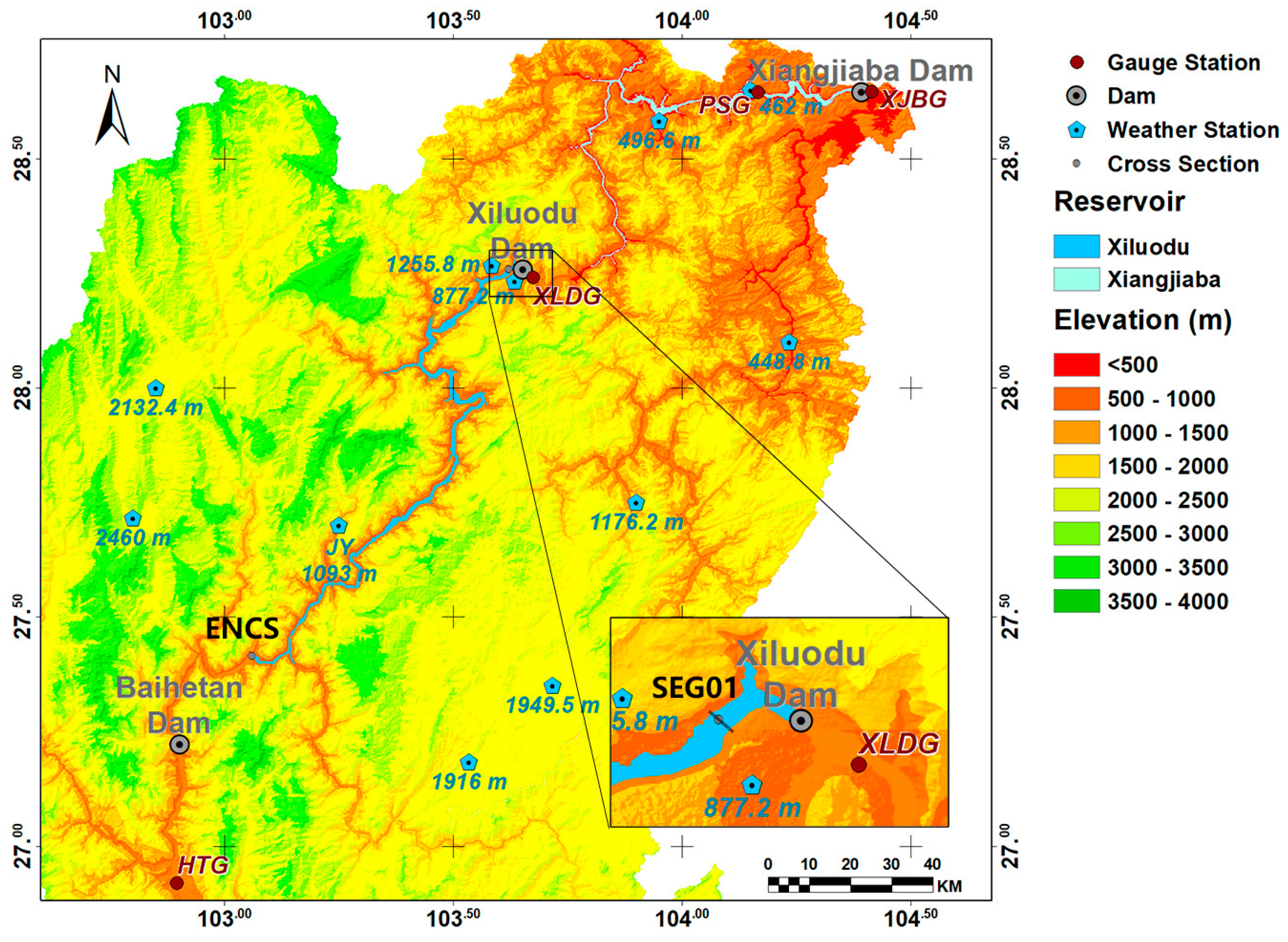
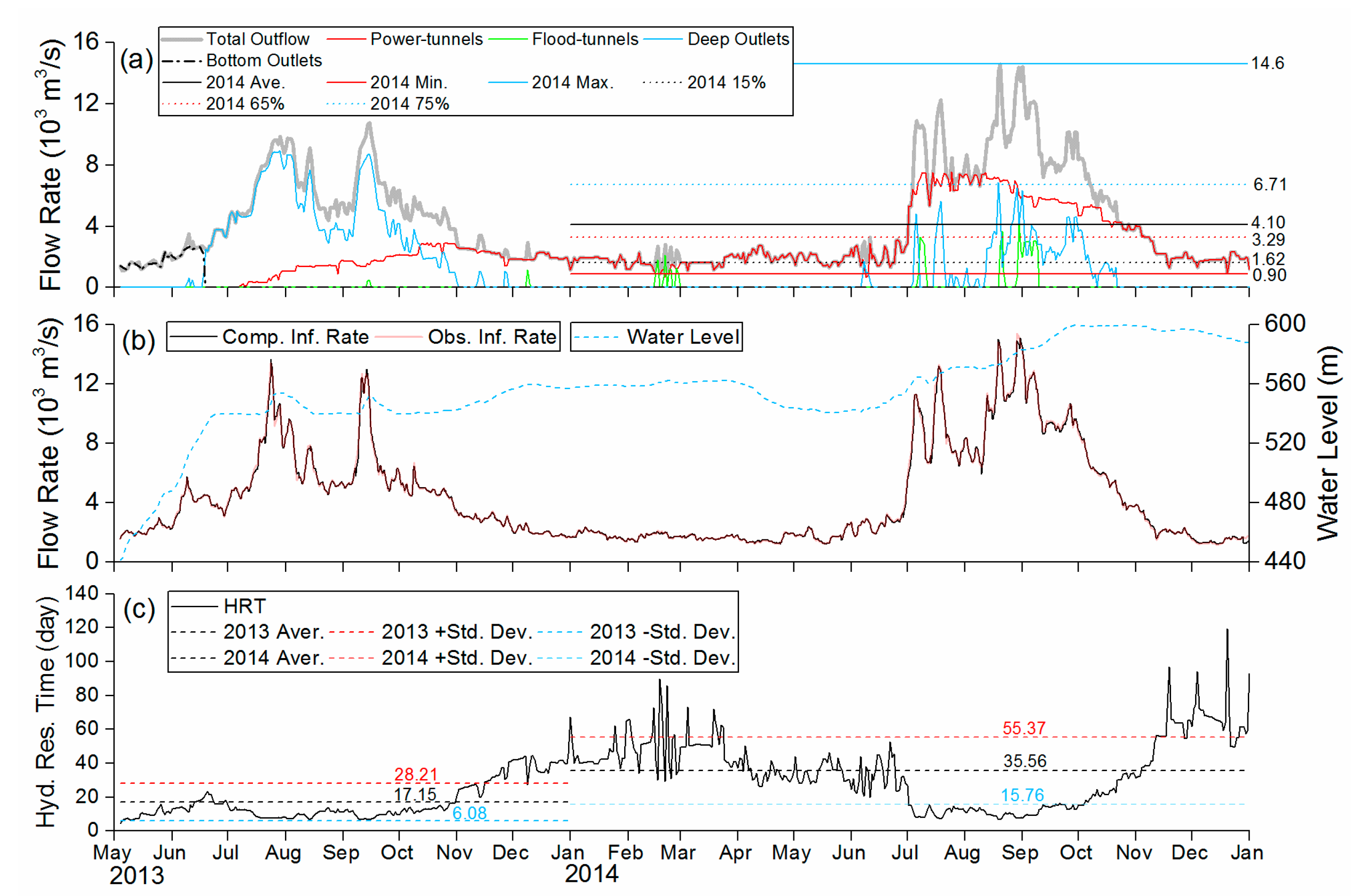



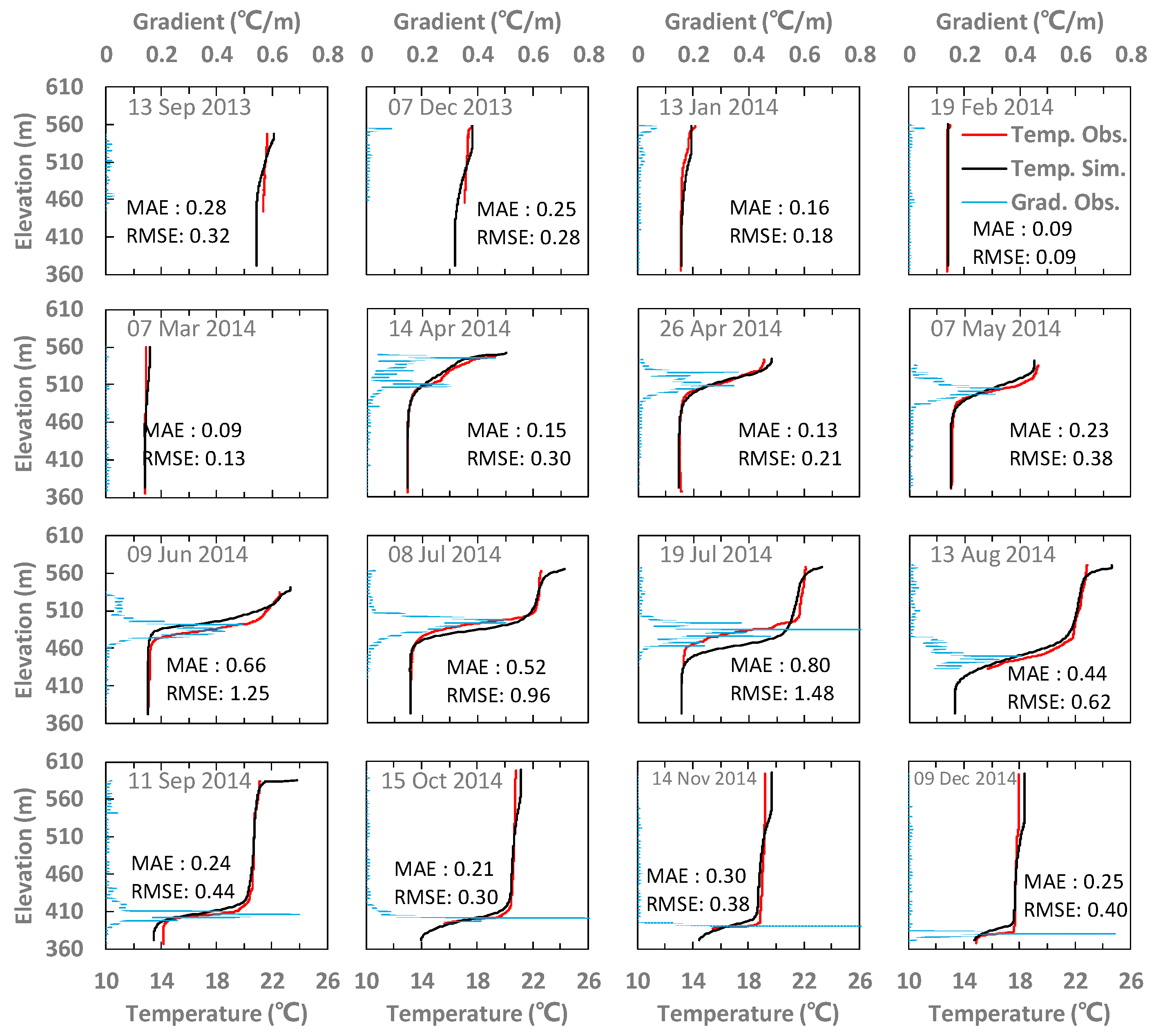

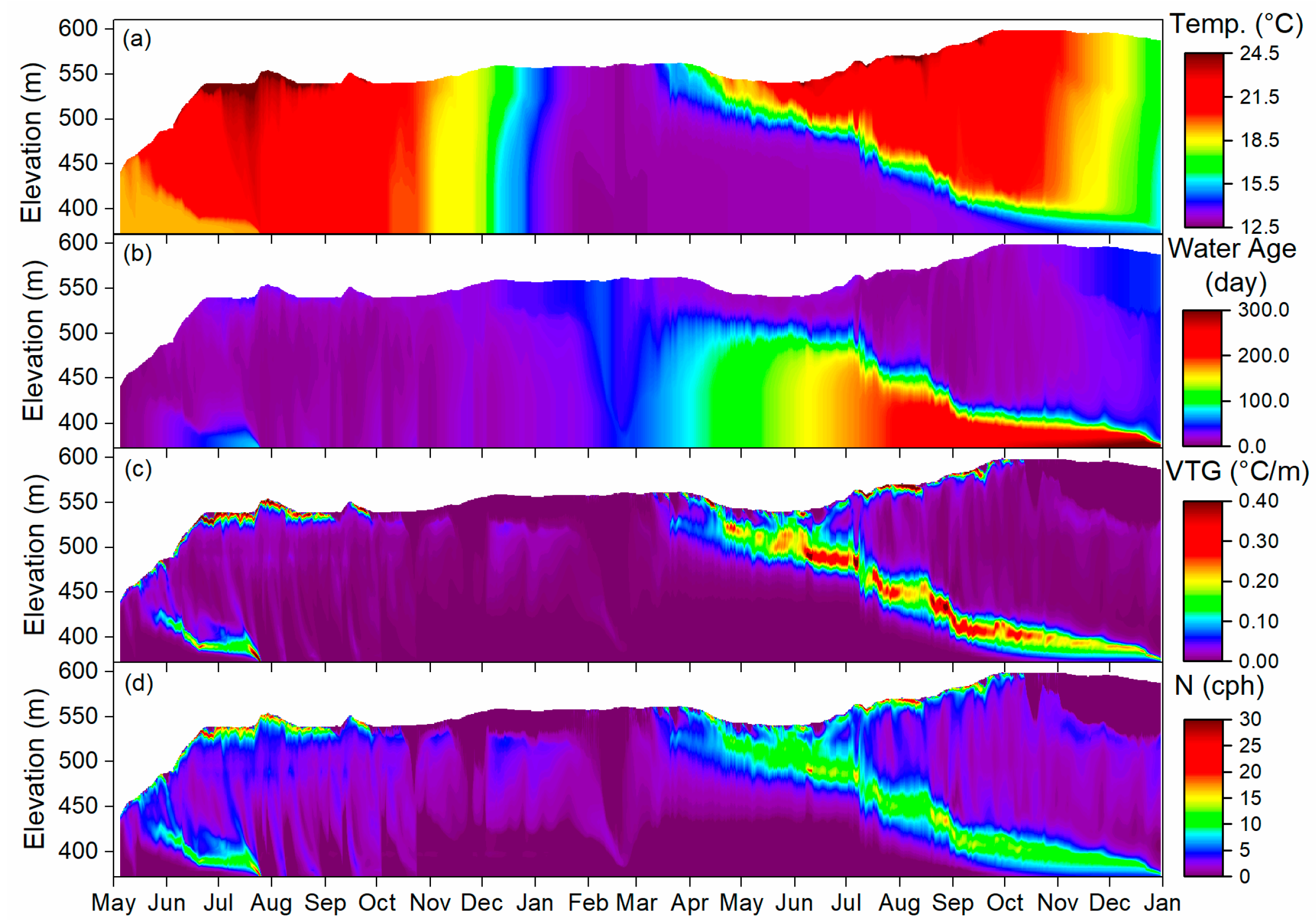


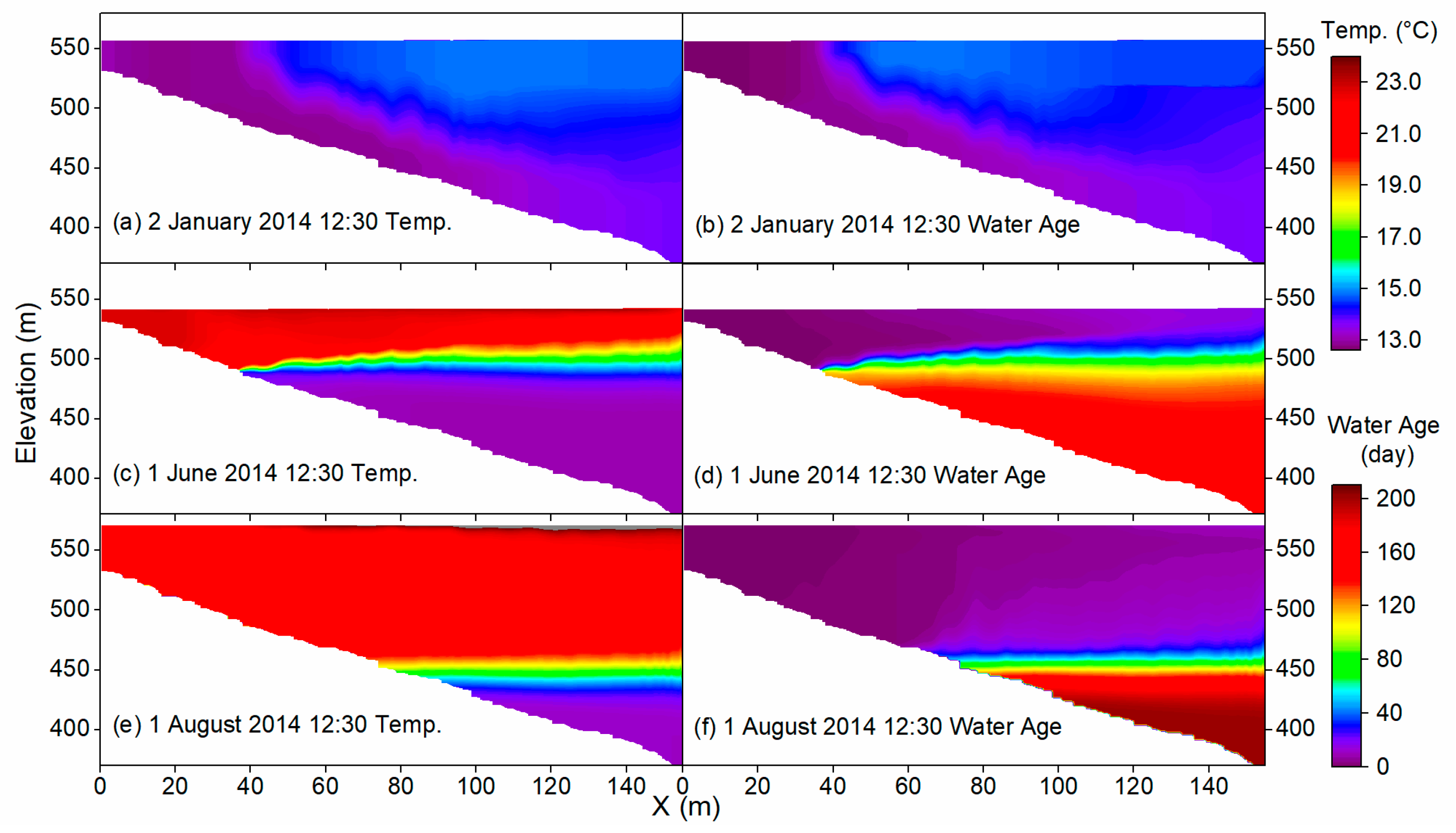
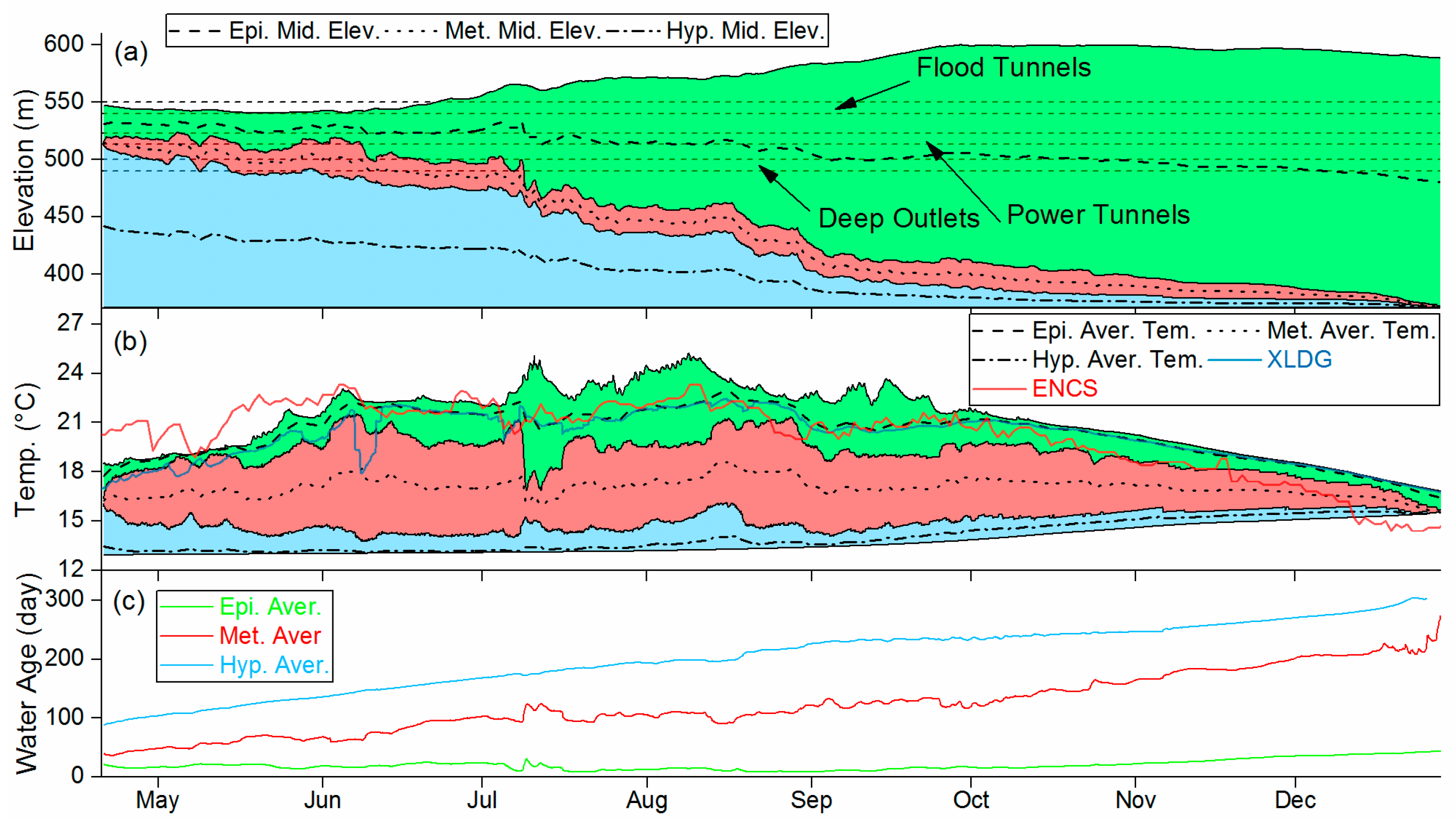


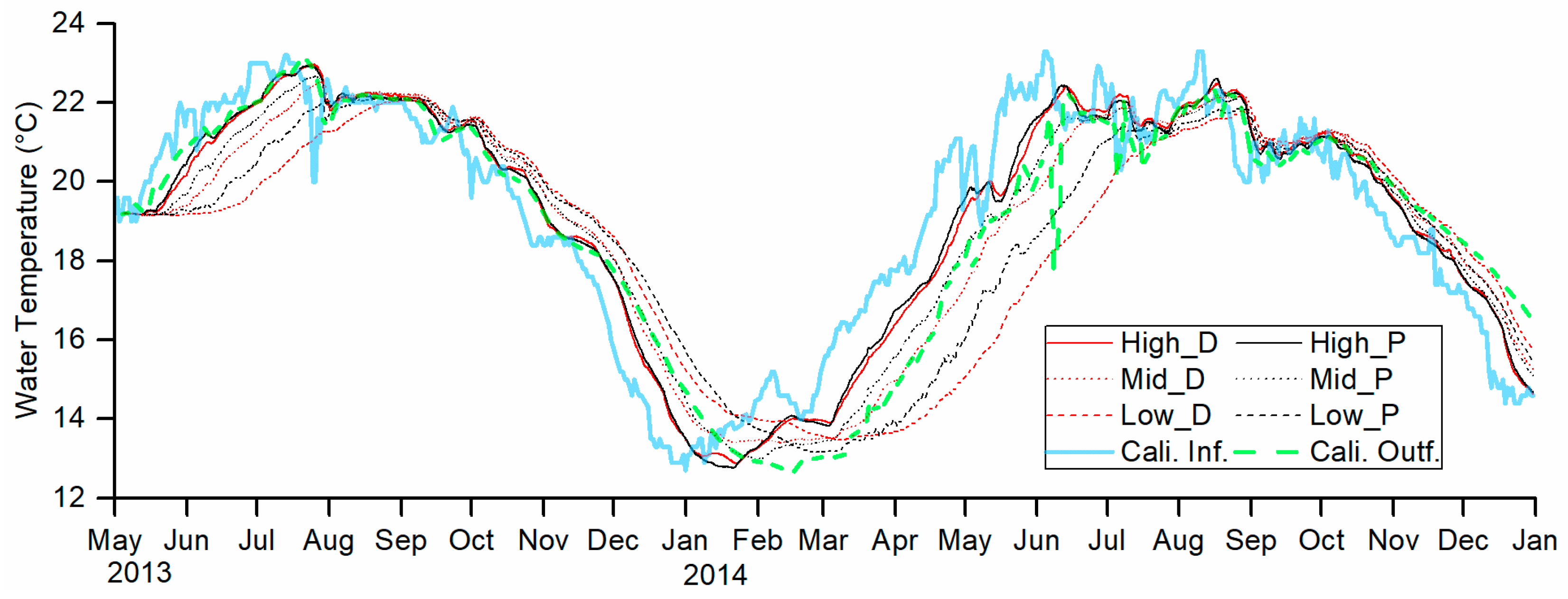
| Abbreviation | Description |
|---|---|
| XLDR | Xiluodu Reservoir (Impoundment since 2013) |
| XJBR | Xiangjiaba Reservoir (Impoundment since 2012) |
| BHTR | Baihetan Reservoir (Estimated impoundment in 2022) |
| HTG | Huatan gauge station (235.1 km upstream to the Xiluodu Dam) |
| XLDG | Xiluodu gauge station (2.9 km downstream to the Xiluodu Dam) |
| PSG | Pinshan gauge station (29.1 km upstream to the Xiangjiaba Dam) |
| XJBG | Xiangjiaba gauge station (2.4 km downstream to the Xiangjiaba Dam) |
| JY | Jinyang weather station |
| SEG01 | A cross-section 3.5 km upstream to the Xiluodu Dam |
| ENCS | The entrance cross-section of XLDR (155 km upstream to the Xiluodu Dam) |
| W2 | CE-QUAL-W2 |
| Month | January | February | March | April | May | June | July | August | September | October | November | December |
|---|---|---|---|---|---|---|---|---|---|---|---|---|
| (°C/100 m) | 0.356 | 0.300 | 0.351 | 0.385 | 0.420 | 0.429 | 0.452 | 0.464 | 0.417 | 0.413 | 0.406 | 0.385 |
| R2 | 0.893 | 0.818 | 0.877 | 0.915 | 0.955 | 0.985 | 0.991 | 0.992 | 0.984 | 0.978 | 0.962 | 0.927 |
| Scenarios | High_Power | High_Deep | Mid_Power | Mid_Deep | Low_Power | Low_Deep | |
|---|---|---|---|---|---|---|---|
| Outflow Through | Power tunnels | Deep outlets | Power tunnels | Deep outlets | Power tunnels | Deep outlets | |
| Percentile of outflow | 75% | 75% | 65% | 65% | 15% | 15% | |
| Constant flow Rate (m3/s) | 6710 | 6710 | 3290 | 3290 | 1620 | 1620 | |
| 17 °C isotherm‘s elevation (m a.s.l.) (in metalimnion) | 1 July 2014 | 453.5 | Bottom | 489.0 | 421.0 | 503.5 | 452.5 |
| 1 October 2014 | 415.0 | Bottom | 476.0 | 410.0 | 496.0 | 442.0 | |
| Deep. Rate (m/day) | 0.42 | / | 0.14 | 0.12 | 0.08 | 0.11 | |
| Water Age (day) at 400 m a.s.l. (in hypolimnion) | 1 July 2014 | 149 | 11.0 | 184.3 | 170.0 | 187.9 | 202.7 |
| 1 October 2014 | 205 | 13.6 | 273.9 | 260.0 | 279.6 | 293.8 | |
| Incre. Rate (days/day) | 0.609 | 0.028 | 0.974 | 0.978 | 0.997 | 0.990 | |
| Scenario | Type | a (°C) | b (°C) | c (Days) | Phase Delay (Days) | RMSE (°C) |
|---|---|---|---|---|---|---|
| Calibration | ENCS Inflow | 18.78 | 4.01 | −110.23 | 0.96 | |
| Outflow | 18.18 | 4.29 | −137.44 | 27.20 | 1.00 | |
| High_Deep | Outflow | 18.51 | 4.32 | −124.94 | 14.70 | 0.83 |
| Mid_Deep | Outflow | 18.22 | 4.37 | −137.04 | 26.81 | 0.64 |
| Low_Deep | Outflow | 17.68 | 4.23 | −155.71 | 45.47 | 0.33 |
| High_Power | Outflow | 18.51 | 4.26 | −123.43 | 13.20 | 0.88 |
| Mid_Power | Outflow | 18.27 | 4.31 | −131.98 | 21.75 | 0.73 |
| Low_Power | Outflow | 17.88 | 4.27 | −147.02 | 36.78 | 0.46 |
© 2017 by the authors. Licensee MDPI, Basel, Switzerland. This article is an open access article distributed under the terms and conditions of the Creative Commons Attribution (CC BY) license (http://creativecommons.org/licenses/by/4.0/).
Share and Cite
Xie, Q.; Liu, Z.; Fang, X.; Chen, Y.; Li, C.; MacIntyre, S. Understanding the Temperature Variations and Thermal Structure of a Subtropical Deep River-Run Reservoir before and after Impoundment. Water 2017, 9, 603. https://doi.org/10.3390/w9080603
Xie Q, Liu Z, Fang X, Chen Y, Li C, MacIntyre S. Understanding the Temperature Variations and Thermal Structure of a Subtropical Deep River-Run Reservoir before and after Impoundment. Water. 2017; 9(8):603. https://doi.org/10.3390/w9080603
Chicago/Turabian StyleXie, Qike, Zhaowei Liu, Xing Fang, Yongcan Chen, Chong Li, and Sally MacIntyre. 2017. "Understanding the Temperature Variations and Thermal Structure of a Subtropical Deep River-Run Reservoir before and after Impoundment" Water 9, no. 8: 603. https://doi.org/10.3390/w9080603






